Kia Ceed 2019 long-term review
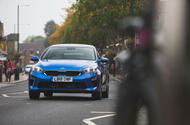 The latest Ceed is the best yet. But is it now good enough to be a real contender?
The latest Ceed is the best yet. But is it now good enough to be a real contender?
Why we’re running it: To see if the new, Europe-designed Ceed is a true Volkswagen Golf rival or still a bit of a family hatchback also-ran
Month 3 - Month 2 - Month 1 - Specs

Life with a Kia Ceed: Month 3
We’ve traded a top-spec one for the entry model. Any regrets? - 23rd January 2019
Do you know anyone who has bought an entry-level car in recent years?
I don’t. Such is the culture of easy sell-ups and tempting lease deals, it’s usually a no-brainer to pay an often heavily discounted sum to upgrade.
In fact, some manufacturers have actively removed the lowest rung on their trim level ladder due to lack of interest. But should you always spend more to get extra equipment you may never use?
That’s what I’ll establish as I take custody of the cheapest Kia Ceed you can buy new.
Last September, I started running the premium-brand-baiting 1.4-litre First Edition Ceed. For the princely sum of just under £27,000, you get, as I’ve outlined in previous reports, a staggering array of kit for a family hatchback.
But while it was all very nice, I knew that if it was my miraculously earned £27k, I’d want something with a darn sight more than 138bhp. So with a desire to explore just how broad the Ceed’s appeal could be, I went to the other end of the range spectrum – the same spec of Ceed that we compared it with in November last year.
And it seems that Kia has joined the ranks by axing its true base model, with no 1-trim variant for this generation. That means the price jumps by around £3000 to this 2 spec – steep in isolation but in line with where rivals begin now. A quick comparison of contract hire deals shows a saving of around £70 per month by going for the base model.
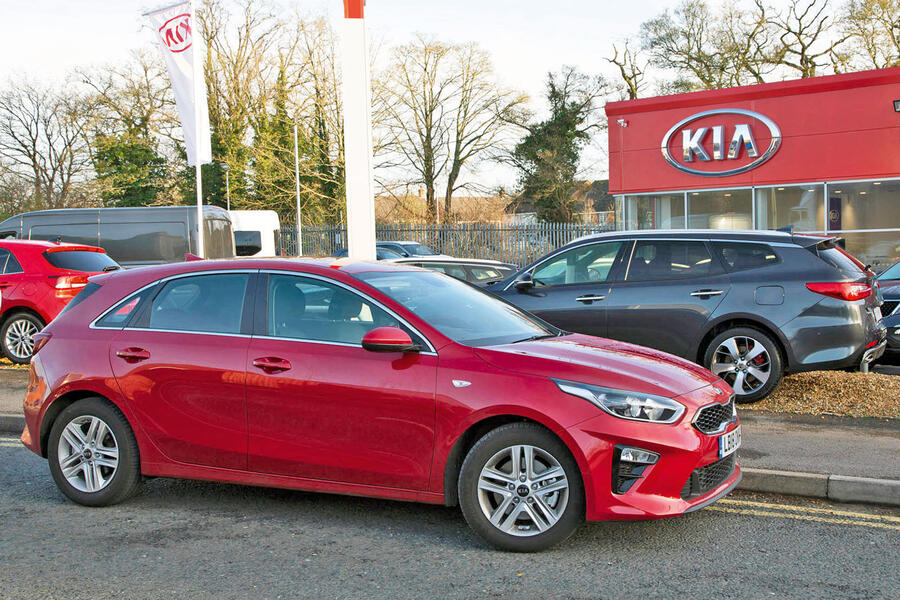
Unsurprisingly, given the price jump, it doesn’t feel like a base model. You still get a touchscreen with Android Auto and Apple CarPlay (you don’t in a base Ford Focus), cruise control of the non-adaptive variety (which I actually prefer) and lane keep assist (which is turned off immediately on start-up). Heck, there’s even a standard spare wheel – a rarity these days.
You also get more power than you might expect. Whereas a similarly priced Focus or Vauxhall Astra will be lumbered with a sub-100bhp motor, the Ceed 1.0-litre triple makes a healthier 118bhp. For comparison, my old 1.4 had 15% more power for more than £8000 extra.
However, this 1.0 doesn’t have as punchy a mid-range as the very best turbo triples. It needs some revs, both to get it off the line smoothly and to get up to speed.
Fuel economy seems barely better than with the 1.4 on first impressions, with an average of around 45mpg on my gentle commute – reasonable, but not remarkable. The current average is the result of a number of town trips over the Christmas holidays, but I reckon this is one of those cases where a relatively heavy car gives a small-capacity engine a harder time when keeping pace at higher speeds.
With just under 1000 miles covered upon delivery, this engine may loosen up over time, but currently it seems I’ll be mourning the 1.4’s greater balance of power and economy. I won’t be missing that car’s larger wheels, though. As I mentioned in November, the more modest 16in items on this car benefit both ride compliance and road noise.
The cheapest Ceed also still gets the costlier multi-link rear suspension: editor Mark Tisshaw’s £28,000 Mercedes A-Class makes do with a cheaper, simpler torsion beam set-up. I may be missing some features, but so far it seems like this base model isn’t one you need to avoid.
Love it:
VALUE FOR MONEY It’s pricier than the old Ceed but this spec still looks good value next to entry-level rivals, with more kit and performance than most.
Loathe it:
BLUNTED PERFORMANCE Not ‘loathe’ exactly, but the engine’s performance isn’t as sprightly as we’re used to with the best three-cylinder turbos.

A few negatives, but only if you’re picky - 2nd January 2018
Recently, I succeeded at eliminating a pesky rattle in the Ceed’s roof headlining with a piece of carpet underlay and a Phillips screwdriver. Great. But now I can’t stop noticing how the keyfob buzzes in its little slot in the centre console, a foible shared with most cars with keyless start. Notice how I’m nitpicking? Truth is, the Kia is a thoroughly complete car that’s very difficult to fault.
Mileage: 3478

Life with a Kia Ceed: Month 2
Buttons are a blessing - 28 November 2018
Late-night airport runs leave me tired, stressed and susceptible to being easily wound up. Thankfully, the Ceed has this uncanny ability to relax you with its cabin’s ease of use. Simple tasks like turning lane keep assist off, changing media sources and dimming instrument backlights can be done in a split second with old-school physical buttons.
Mileage: 2817

Is our top-spec car really £8k better than the entry-level one? - 14 November 2018
Really? £27,000? You can get an [insert supposedly more premium rival here] for that!” It’s a phrase I’ve heard more than once when people ask about the top-spec Kia Ceed I’m running. It’s a fair point when you think that £27k will very nearly get you into a base Audi A4.
My stock advice is that more modest trim levels better balance necessary equipment and list price. But it’s not a view shared by buyers. Manufacturers are increasingly finding that the higher trim levels are the most popular choice, particularly when packaged into a PCP deal.
As luck would have it, we had an entry-level Ceed in for a separate test, so I leapt at the chance to get them together and see if my First Edition spec could justify its £8000 premium. First off, let’s look at appearance, inside and out. The Ceed isn’t the most attention-grabbing hatch, but it majors on classy understatement.
The entry-level car obviously retains the same basic shape, but a few key design elements are missing.
For example, it has the same LED running lights as the top-spec car but ditches the full LED headlights in favour of less premium-looking halogen bulbs. The door mirrors, as well as losing their auto-folding mechanism, ditch the LED indicators and puddle lights of the range-topper. The wheels are an inch smaller, too, and there’s no privacy glass.
Nothing dramatic, then, but the changes are enough to give the Ceed less kerb appeal, to my eyes. But it’s the interiors that most set the two trims apart – not just the way they look but also the way they feel. Soft leather upholstery, padded door inserts and glossy plastics are replaced by a notably less tactile and more austere environment. Little details make all the difference here, too, such as the cool white LED interior lighting of my car swapped for dull yellow bulbs.
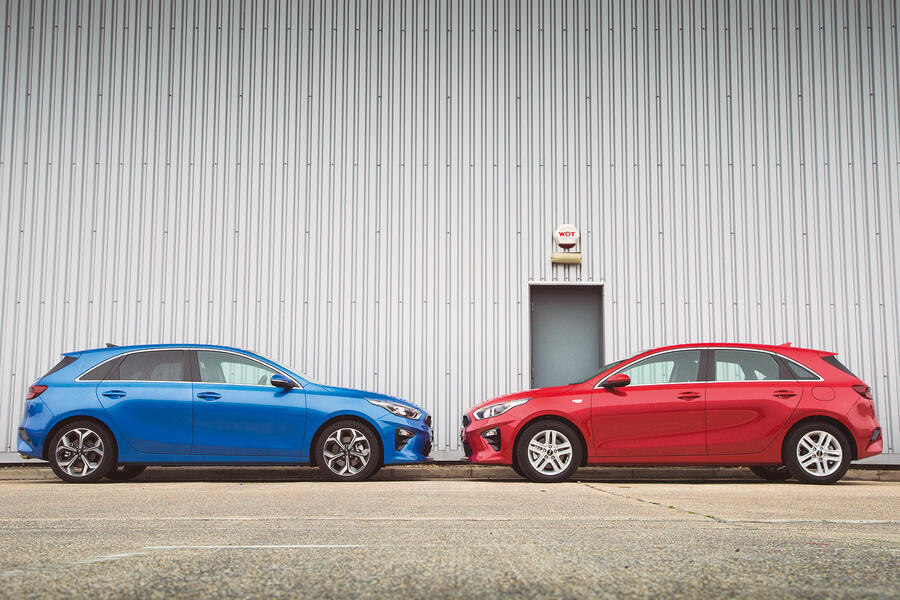
Of course, my Ceed has far more standard kit, but the base Ceed isn’t totally spartan. There’s still a touchscreen (albeit with an inch lopped off the display and no satnav), cruise control, DAB and a rear-view camera, but the seats have manual adjustment and the air-con isn’t automatic. For reliable, simple transport, it’s utterly fit for purpose. The differences on the road are perhaps more surprising.
It’s the cheaper Ceed that’s more comfortable overall, with the extra inch of tyre sidewall allowing for greater bump absorption at lower speeds and less road noise.
Whether you prefer the reasonably slick manual shift or the largely smooth seven-speed automatic is personal taste, but the greater degree of control (coupled with the lack of paddle shifters for the auto ’box) sways me towards the manual option. The First Edition’s four-cylinder motor doesn’t have the all-round refinement advantage over the base 1.0-litre three pot you might expect, either. Sure, at lower revs, the fourpot is arguably less intrusive and smoother, but the reverse is true at high revs, where the 1.4-litre engine becomes coarse.
Of course, the 1.4-litre offers more power and, crucially, more low-down torque, feeling more muscular in the process. The 1.0-litre needs to be worked a fair bit harder in the same situations, meaning that it was only around 5mpg more economical over the same journey.
Overall, although I prefer the added luxury and performance of my top-spec Ceed, it would have to be seriously tempting on a monthly payment basis for me to justify the 40% price jump.
Love it:
Upmarket feel inside First Edition spec brings a cabin that looks premium enough to take on the German establishment.
Loathe it:
Noises off The firm edge to the ride is exacerbating an annoying clicking noise behind the roof headlining.
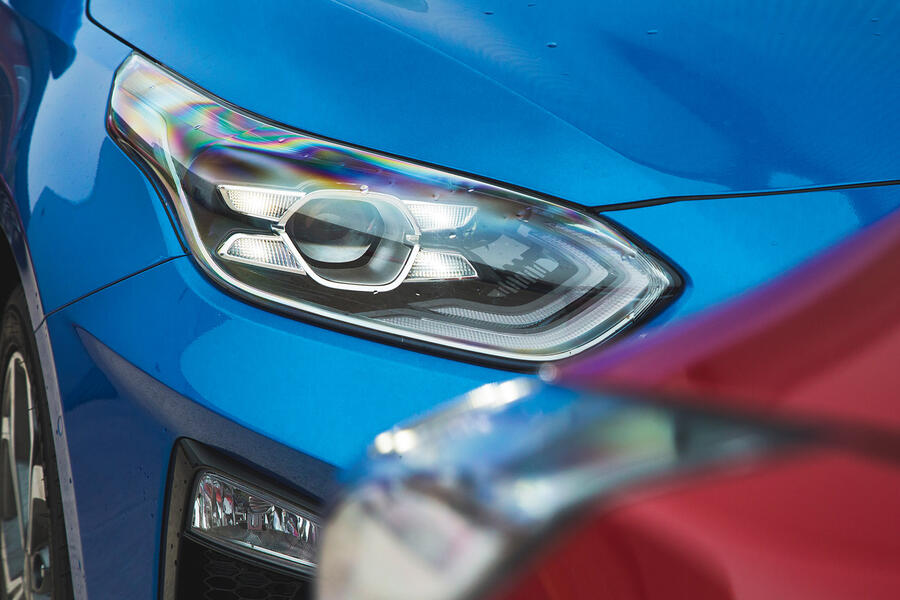
Mileage: 2420
Life with a Kia Ceed: Month 1
Ceed sees its first cold weather - 31 October 2018
Mid-October saw the first morning commute start with ice covering the Ceed’s windscreen. Our top-spec car comes with heated seats (great) and a heated steering wheel (even better) but no heated front screen. In an ideal world, I’d sacrifice the passenger seat heater to have the screen clear quickly, because I’m selfish like that.
Mileage: 2019

Welcoming the Ceed to the fleet - 17th October 2018
Crossovers might be increasingly dominant in the family car sales charts, but hatchbacks remain the bread and butter of many car makers’ ranges. Cars such as the Ford Focus and Volkswagen Golf are of vital importance to the industry and buyers alike, as reflected in the billions of pounds spent on the development and marketing of them.
New entrants to the market often have a difficult time establishing themselves and the previous two generations of the Kia Ceed – despite being perfectly competent – took time to make the necessary dent in the more established competition.
But Kia’s determination to crack the European hatch market has resulted in a C-segment car that is now designed in Europe, built in Europe and will be sold exclusively in Europe. So we’re running one for a few months to see, first, if it feels like a true European hatchback and, second, if such a car should still have a place in buyers’ minds alongside the ever-growing menagerie of crossovers and SUVs.
Well, our esteemed road testers think that the new Ceed has “fulfilled its potential” in this generation, making it “more worthy of recommendation than all but the very best cars in one of the toughest market segments in the world”. Who am I to disagree?
Exterior impressions, however, don’t seem to paint our Ceed as a particularly revolutionary car. With design head Peter Schreyer’s influence from his time at the Volkswagen Group, the Ceed appears to just about toe the line between the understated class of a Golf and complete anonymity. Despite this, it does seem to attract looks from passers-by – although that could be largely down to our car’s lovely Blue Flame paint. The subtle bodykit and 17in alloy wheels add a touch of visual appeal too.
We’ve opted for the top-spec First Edition model, which looks steep at a smidgen under £27,000 but is loaded to the gills with toys. The kit tally includes LED headlights, a large electric sunroof, a JBL sound system, smart park assist with front and rear sensors, an 8.0in touchscreen sat-nav and smart cruise control. There’s also an impressive array of other driver assist aids, which I’ll report on in detail once I’ve used them more.
What does mark the Ceed out are its fronts seats, which are not only electric and heated (the rears are heated too) but also ventilated – something usually found in only high-end models. A heated steering wheel should also ensure gloves won’t be needed when the weather turns bitter.
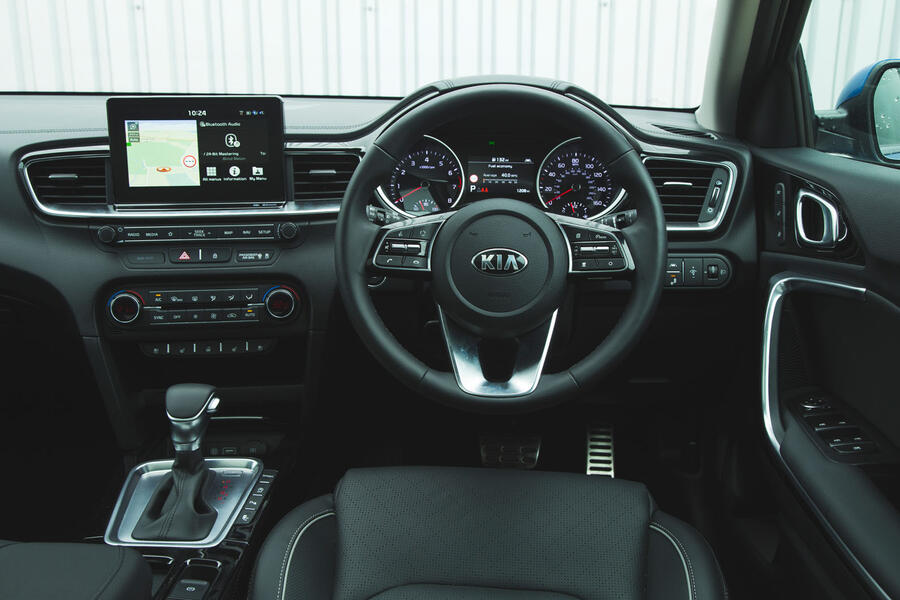
The interior overall stands out not just because of the kit but also the quality. This is as close to a Golf as Kia has ever been, with glossy or soft-touch plastic that’s pleasing to the eyes and touch, an attractive design and neat extras, such as the wireless phone charger under the centre stack.
Little touch points also show the effort Kia has made to improve perceived fit and finish, including the sliding cover for the USB and 12V points in the dashboard, which is so nicely damped that it wouldn’t be out of place in a Mercedes-Benz S-Class.
The only thing that’s taking the shine off so far is the passenger’s grab handle, which has started to rattle over bumps. I’ve yet to trouble the Ceed’s rear-seat room or boot space, but both appear generous enough for family life or a light weekend away.
Our Ceed isn’t just fully loaded in terms of trim: it also has the most powerful engine available at launch (before the Ceed GT arrives). The 1.4-litre turbo petrol four-pot pumps out a modest 138bhp but a healthy 178lb ft of torque, and is mated to Kia’s seven-speed dual-clutch gearbox.
With less than 1000 miles on the clock, it’s barely run in, but performance is little more than adequate. The 0-62mph dash takes 8.9sec, which is unremarkable for a top-flight engine, and that’s how it seems on the road. It feels punchy and smooth after an initial throttle deadness, which eggs you on to start extending it, but above 4000rpm, all you get is a rather coarse engine note without much additional oomph. At least it’s impressively refined when taking it easy, where the dual-clutch ’box is better at timing and dampening its gearshifts.
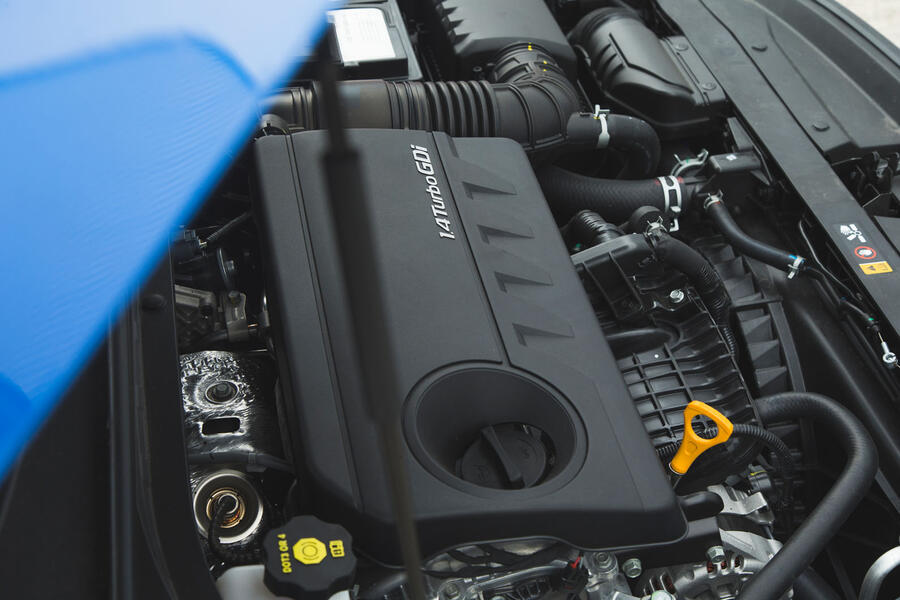
It’s a pity the engine is merely average because the Ceed is a surprisingly agile and composed steer, based on first impressions. The taut chassis set-up means body control is tight and the steering perfectly balances directness and high-speed stability. One trade-off for this is that the ride is a little firmer around town than it should be, although it’s still an improvement on the outgoing Ceed in that respect.
Minor gripes aside, the initial outlook is positive for our EuroKorean hatch. Even fuel economy is better than expected, as I’m averaging 43mpg on mixed town and motorway work without really trying. We’ll see over the next few months if the Ceed can offer the ownership proposition of the class’s big hitters.
Second Opinion
There’s no doubt that the new Ceed is one of the more inspiring hatchbacks to drive, but I still think Kia hasn’t got the ride quite right. There’s a nervous fidget that never really settles – and our car’s 17in alloy wheels aren’t exactly oversized.
Jimi Beckwith
Kia Ceed 1.4 T- GDI First Edition DCT specification
Specs: Price New £26,850 Price as tested £26,850 Options none
Test Data: Engine 4cyls, 1353cc, turbocharged, petrol Power 138bhp at 6000rpm Torque 184lb ft at 1500-3200rpm Kerb weight 1315kg Top speed 130mph 0-62mph 8.6sec Claimed fuel economy 48.7mpg Test fuel economy 42.9mpg CO2 132g/km Faults Grab handle rattle Expenses None

Comments
Post a Comment